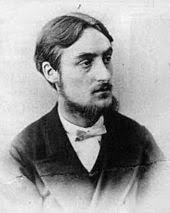 I’ve been
reading a lot of Gerard Manley Hopkins’ poetry recently. And I've realised that his sonnets can offer
relief and hope for people going through a period of deep distress.
I’ve been
reading a lot of Gerard Manley Hopkins’ poetry recently. And I've realised that his sonnets can offer
relief and hope for people going through a period of deep distress.
I’m going to
show you what I mean in this series of posts.
Hopkins was
one of the most original poets writing in English during the 19th
century. Throughout his life he
experienced a range of intense emotions, from utter misery to great joy. And he
has an astonishing ability to express his emotions in his poetry.
I’ve chosen
six of Hopkins’ sonnets which, I suggest, can take us on a healing journey: from despair, through detachment and
determination, to comfort of self and comfort of others, and finally to delight. The first four are taken from his so-called
‘Terrible Sonnets’, written in Dublin in 1885 during a period of profound sadness. The fifth was written in Liverpool in 1880,
while he was working as a local priest. The final one, his own personal
favourite, was composed in north Wales in 1877.
I’ll present
each poem in turn, and then make some comments on how they might help us.
Four things
before we start on the journey.
- The first three of these sonnets are very bleak indeed, so do take care of yourself while reading them. If they strike a deep chord, then make sure you have someone you can talk them over with.
- Religion is very important to Hopkins, and permeates all his literary imagery. He became a Jesuit priest, having converted to Catholicism (a very radical move at the time) while a student at Oxford. But it is not at all necessary for us to share his beliefs to get immense value from his poetry.
- Sonnet structure: Hopkins adopts the standard 14 lines for each sonnet, like Petrarch and Shakespeare before him. Like Petrarch (but unlike Shakespeare) he usually divides them into two parts: the first eight lines set out the main theme, and the last six lines offering a response. Unlike both Petrarch and Shakespeare, Hopkins often moves away from the standard format of ten syllables a line, with stress on each second syllable; he enjoys experimenting with the length and rhythm of each line.
- Reading the poems: I recommend you read through each one a few times, to get the general style and rhythm in your mind. Then, for maximum effect, read it out loud. This way you really begin to hear how his words sound and interact with each other.
OK, with all this in mind, we can begin. I will introduce the first sonnet for this
journey – ‘No worst there is none’ –
in my next post, in a couple of days’ time.
Very much looking forward to how this journey unfolds. Memories of high school poetry are revealing themselves; long since forgotten despair and darkness and the never ending torture of night time ponderings! I'm looking forward to watching and learning where you take this.
ReplyDeleteI come here when the stages have unfolded though no less in want, need and openness to their infinite relevance.
ReplyDelete‘Utter misery to intense joy’- the two extremes in juxtaposition, the purity of the emotions & the human as a vehicle by which to express that potential had me at the very start of this introductory thunder.
The power of this, again alongside the gentle and reassuring approach of the writer, ‘Chris’, signifies to me the very point of this journey- to feel, to identify, to continue and to be encouraged. I was excited at the first to learn of the beginning title ‘ No worst there is none’ because I need sadness to stay sane. There is a beauty in the human mansion- every room!